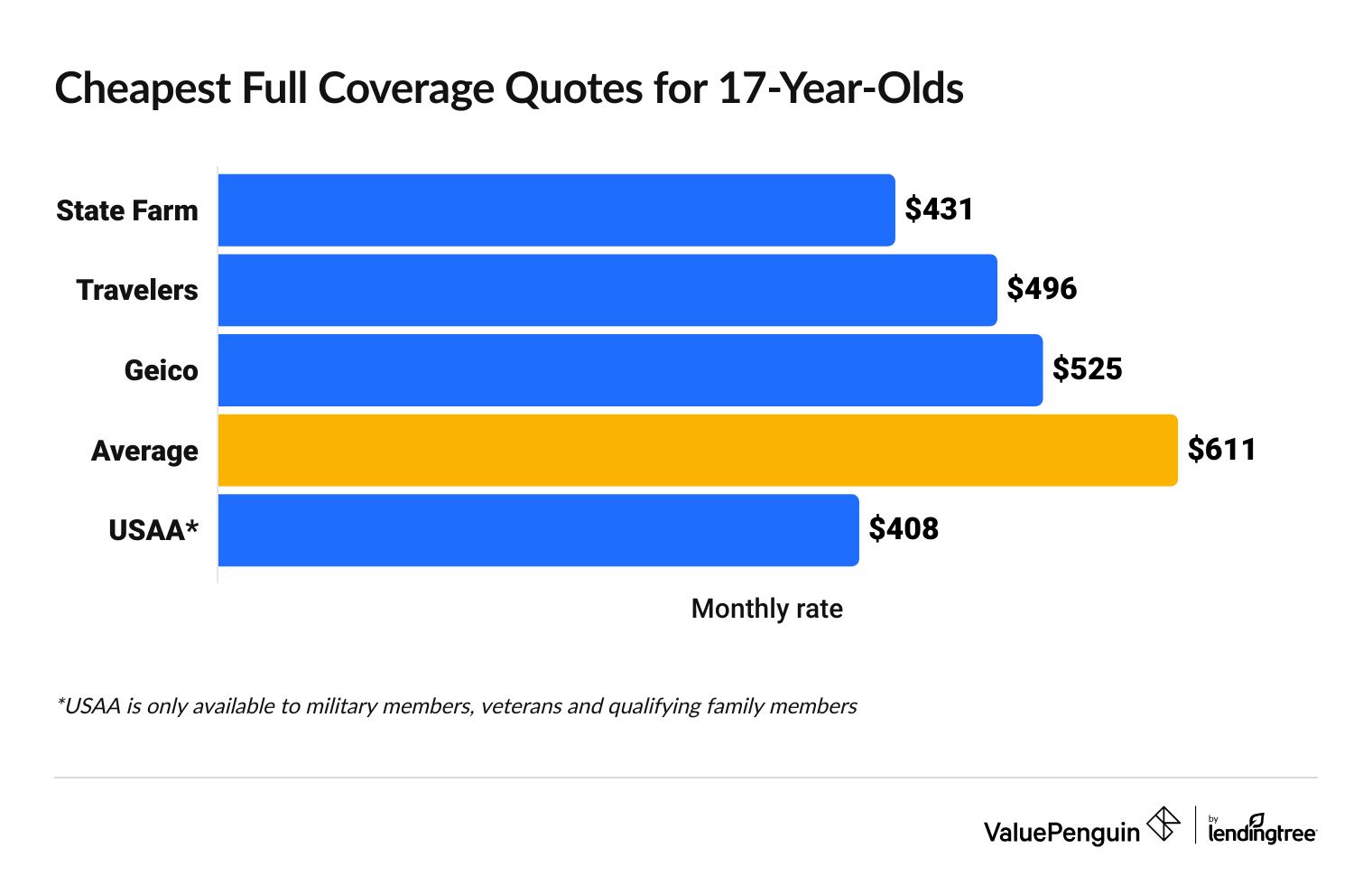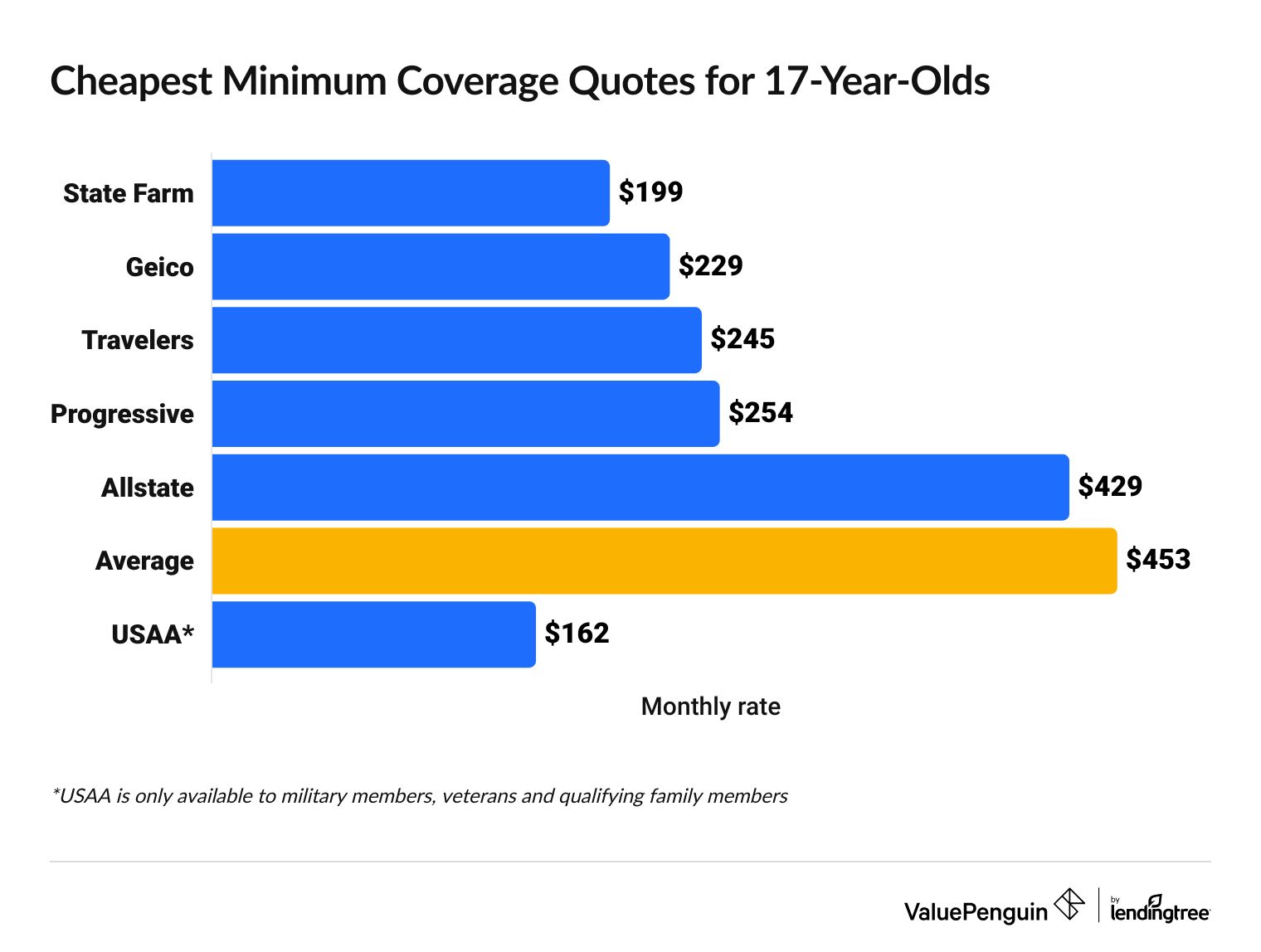How Much Is Car Insurance for a 17-Year-Old?
Car insurance for 17-year-olds costs $611 per month for full coverage and $453 per month for minimum coverage, on average.
State Farm usually has the cheapest rates for 17-year-olds.
USAA might be cheaper, but only people associated with the military can get USAA coverage. Allstate and Farmers are often expensive for 17-year-old drivers.
Find Cheap 17-Year-Old Auto Insurance Quotes
How much is car insurance for a 17-year-old?
Full coverage car insurance for a 17-year-old costs $611 per month, on average.
State Farm has the cheapest average full coverage and minimum coverage rates for 17-year-olds. Travelers and Geico are also cheap options. If you have a connection to the military, you should get a USAA quote. USAA often has very cheap rates, but only certain people can get it.
Find Cheap 17-Year-Old Auto Insurance Quotes
Full coverage is more expensive than minimum coverage because it includes coverage for damage to your own vehicle. It also usually has higher liability limits, which pay for the damage you cause when you hit another car or injure someone with your car. Each company has its own method for setting rates, though. Shopping around can help you find the cheapest car insurance for your situation.
Average cost of car insurance for a 17-year-old
Full coverage
Minimum coverage
Company | Editor's rating | Monthly rate | |
|---|---|---|---|
| State Farm | $431 | ||
| Travelers | $496 | ||
| Geico | $525 | ||
| Progressive | $693 | ||
| Allstate | $798 | ||
*USAA is only available to military members, veterans and their families.
Full coverage
Company | Editor's rating | Monthly rate | |
|---|---|---|---|
| State Farm | $431 | ||
| Travelers | $496 | ||
| Geico | $525 | ||
| Progressive | $693 | ||
| Allstate | $798 | ||
*USAA is only available to military members, veterans and their families.
Minimum coverage
Company | Editor's rating | Monthly rate | |
|---|---|---|---|
| State Farm | $199 | ||
| Geico | $229 | ||
| Travelers | $245 | ||
| Progressive | $254 | ||
| Allstate | $429 | ||
*USAA is only available to military members, veterans and their families.
17-year-old car insurance rates vs. other ages
On average, 17-year-olds pay $103 less each month for full coverage compared to 16-year-olds.
That's because each year that a teen has their license and doesn't have to file a claim, they gain more driving experience and are less likely to get into accidents.
Because they're new to driving, teens have some of the highest car insurance rates. But the cost for coverage gets cheaper every year. By the time you turn 25, you could be paying $390 less each month for full coverage than you were at age 17.
Why is car insurance so expensive for 17-year-olds?
Young drivers are expensive to insure because they are more likely to get into car accidents. In fact, the risk of crashes is higher for drivers age 16-19 than it is for any other age group. Because teens are more likely to get into crashes, insurance companies charge higher rates to make sure they can afford to pay out claims.
Each year that a teen doesn't get into an accident or get a ticket, their rates will probably go down. You might also get a lower rate by getting discounts and shopping around.
How much is insurance for a 17-year-old female vs. a 17-year-old male?
On average, 17-year-old boys pay 10% more for full coverage car insurance compared to 17-year-old girls.
That's because teenage boys are more likely to get into crashes compared to teen girls. The gap between the genders gets smaller as you get older. By 25, men only pay about 2% more than women each month.
Age | Male monthly rate | Female monthly rate | Difference |
|---|---|---|---|
| 16 | $742 | $685 | 8% |
| 17 | $639 | $583 | 10% |
| 18 | $556 | $507 | 10% |
| 20 | $367 | $338 | 9% |
| 25 | $223 | $219 | 2% |
In six states, insurance companies aren't allowed to use gender to set rates.
- California
- Hawaii
- Massachusetts
- Michigan
- Montana
- North Carolina
- Pennsylvania
In these states, 17-year-old boys and girls should pay the same amount, assuming everything else on their policy is the same.
Car insurance rates for 17-year-olds by state
The cost of car insurance for a 17-year-old changes depending on where you live.
In urban areas and areas with higher cost of living, rates are usually more expensive. For example, a 17-year-old pays $708 per month, on average, for full coverage in New York. But the same coverage in Pennsylvania costs an average of $446 per month.
- Illinois: $601
- New York: $708
- Pennsylvania: $446
- Texas: $690
Find the Cheapest Insurers for Young Drivers in Your State
Can a 17-year-old have their own insurance?
Teen drivers usually can't have their own car insurance policy.
That's because car insurance policies are legal contracts, and 17-year-olds aren't yet adults. If a parent wants their teen to have their own policy, an adult will still need to be listed as the policy owner.
It's almost always cheaper for teenagers to be listed on their parents' car insurance policy. Teens can take advantage of their parents' discounts, like savings for bundling auto and home policies, and get a cheaper rate.
How to save on car insurance for 17-year-olds
The best way to get cheaper car insurance for a 17-year-old is to shop around and compare quotes. You should also consider the amount of coverage you buy and ask about discounts.
- Shop around: Insurance companies all have different rates, which means the same coverage can vary by hundreds of dollars per month between companies. Getting car insurance quotes from different companies and comparing them helps you find the cheapest rates for the coverage you need.
- Consider your coverage: Teens are cheaper to insure if they drive older cars, especially if you can avoid buying comprehensive and collision coverage. These coverages pay for damage to your car in an accident. If you can get an older car that you can afford to repair or replace yourself, you could lower your car insurance rate by a lot.
Keep in mind that having proper coverage is important. It's a good idea to review your coverage with a licensed agent so you don't accidentally remove important protections from your policy.
Another great way to save is to use discounts. Most insurance companies offer discounts that can help you get a lower rate. Some common discounts for teens include:
- Good student discount: Most companies require young drivers to have at least a 3.0 GPA — or at least a "B" average — to get this discount. The savings depend on the company, but some companies, like State Farm, give good students up to 25% off. Students might also save by being on the dean's list or honor roll.
- Driver training discount: A driver training course is one of the easiest ways to lower rates for 17-year-old drivers. Often, drivers get a discount for completing a state-approved driver's education class, though some companies offer their own driver's education or defensive-driver courses.
- Distant student discount: If you're a parent and your teen is away at school without a car, you might be able to get this discount. To qualify, the student typically has to go to a school at least 100 miles away.
Frequently asked questions
What's the average insurance rate for a 17-year-old?
On average, 17-year-olds pay $611 per month for full coverage car insurance. For minimum coverage, 17-year-olds pay $453 per month, on average. Car insurance is expensive for 17-year-olds because they don't have much driving experience and are more likely to get into crashes and file claims.
What is the cheapest insurance for a 17-year-old?
State Farm has some of the cheapest car insurance rates for 17-year-olds for both full coverage and minimum coverage. If you're a military member, veteran or qualifying family member, get quotes from USAA, too.
Does car insurance go down at 17?
Car insurance is cheaper at 17 than it is at 16, but it's still pretty expensive. Every year that a teen has their license and doesn't have an accident or get a ticket, their rates should go down.
Methodology
ValuePenguin determined the average cost of car insurance for 17-year-olds by getting quotes from seven large insurance companies in Illinois, New York, Pennsylvania and Texas, four of the most populated states in the country. Not every company was available in every state.
Rates are for 17-year-old boys and girls with a 2015 Honda Civic EX, good credit and no accidents or tickets. Minimum coverage rates are for the state-required coverage.
Full coverage rates have higher liability limits plus comprehensive and collision coverage:
- Bodily injury liability: $50,000 per person and $100,000 per accident
- Property damage liability: $25,000 per accident
- Uninsured and underinsured motorist bodily injury: $50,000 per person and $100,000 per accident
- Personal injury protection (PIP): Minimum, when required by state
- Medical payments: $5,000
- Comprehensive and collision deductible: $500 deductible
Rates are from Quadrant Information Services, which in turn gets data from publicly available insurance company filings. The rates in this article are for comparison only. Your rates will be different.
Editorial Note: The content of this article is based on the author's opinions and recommendations alone. It has not been previewed, commissioned or otherwise endorsed by any of our network partners.







